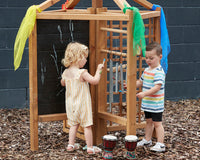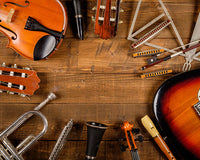 Starting to play the electric guitar can seem daunting when you're met with knobs, switches and input jacks! If moving from acoustic to electric the more "technical" appearance can be a bit overwhelming also. Though in reality the basics of how an electric guitar works are very simple.
Starting to play the electric guitar can seem daunting when you're met with knobs, switches and input jacks! If moving from acoustic to electric the more "technical" appearance can be a bit overwhelming also. Though in reality the basics of how an electric guitar works are very simple.
Getting Started
One thing that people often get confused about is that an electric guitar is essentially the same as the acoustic guitar in terms of how it's played and tuned. Electric guitars tend to have thinner necks and lighter strings (making it easier to do things like bend strings). As for the controls on the guitar, they are only used when the guitar is plugged into an amplifier. A common mistake is overlooking the amplifier, which is needed to create any real volume. Of course it's possible to play without one, it'll just be very quiet! Many beginner guitars will come in packages with amplifiers, otherwise you will have to buy one. Though now it's possible to plug your guitar into your computer or phone and use various apps and programs. This will emulate the sounds of an amplifier, so you can practice without bothering the neighbours! Win, win! To plug in the guitar, insert the cable into the input jack which will be quite obvious and often it is located on an oval shaped plate on the bottom corner of the body. Alternatively you'll be able to plug in on the bottom edge of the guitar.What is a Pickup?
Now that the easy bit's over the next thing to understand is the pickups. There will be two or three magnetic bits sticking up under the strings on the body of the guitar, these are called the "pickups". This is what picks up the sound from the strings and sends it to the amp, they work similarly to how microphones work.The Types of Pickups
-
 There will usually be a pickup close to the bridge (where the strings connect to the body), one close to the neck and occasionally one in the middle. They are commonly named the "Bridge", "Middle" and "Neck" pickups.
There will usually be a pickup close to the bridge (where the strings connect to the body), one close to the neck and occasionally one in the middle. They are commonly named the "Bridge", "Middle" and "Neck" pickups. - You can change which pickup is activated as each one will provide a different tone, you can do this by using switches next to the pickups!
- Bridge pickups tend to sound more twangy and slightly thinner, middle pickups sound quite full with some bite, where Neck pickups are warmer and sound more "round" or smooth.
- When the switch is set to use two pickups at once it will sound like a combination of the two sounds.
- If the guitar has two pickups there will generally be a three way switch, meaning it has three settings. Also, when there are three pickups then there will be a five way switch, meaning it has five settings.
- When the switch is set to the "bottom" position then the bridge pickup is in use. If there are three pickups, when set to the middle the middle pickup is active. If there are two pickups it will activate both of them. When set to the position which is more "Upwards" this activates the neck pickup. If the guitar has three pickups then the "in-between" positions will activate either the bridge and middle, or the neck and middle pickups.
- Occasionally a guitar will only have one pickup, meaning you don't have to worry about switching between sounds!
The Knobs
-
 The knob closest to the strings will control the volume, if turned all the way down no sound will come out of the amplifier at all.
The knob closest to the strings will control the volume, if turned all the way down no sound will come out of the amplifier at all. - Some guitars will have two volume knobs, this usually means that there is one volume control per pickup (so even if one is all the way down, if the switch is set to use the opposite pickup then the sound will still come out of the amp). The next one often labelled "Tone" is what is technically called a "low-pass filter", which basically means that if you turn it down it makes the sound a bit warmer, if turned all the way down it can sound a bit muffled, especially on the neck pickup which naturally sounds quite warm anyway.
- Many guitars have one tone knob which controls the whole guitar, if the guitar has two pickups and two tone knobs then there will be one tone per pickup. If there are three pickups and two tone knobs then generally the closest tone knob to the strings will affect the neck pickup, and the lower on will affect the middle pickup.
- Most players will leave the tone knobs set to full and rarely adjust them, so it's best not to worry too much about those right away!
Tell Me..What is a Whammy Bar?
 Some guitars come with a whammy bar which attaches to the bridge, this can be pushed down to lower the pitch of the guitar while playing, this can be a fun way to make some interesting sounds that wouldn't normally come from a guitar but if used too much or too aggressively the guitar can be put out of tune. So use with care! But again, many players won't really find much use for this and will leave the whammy bar untouched in their guitar case.
Some guitars come with a whammy bar which attaches to the bridge, this can be pushed down to lower the pitch of the guitar while playing, this can be a fun way to make some interesting sounds that wouldn't normally come from a guitar but if used too much or too aggressively the guitar can be put out of tune. So use with care! But again, many players won't really find much use for this and will leave the whammy bar untouched in their guitar case.
This should cover everything that will be seen on any beginner level electric guitar and will hopefully give you a good idea of how it all works! If you have any questions or would like us to talk you through it, you can call us 01283 53533.




















